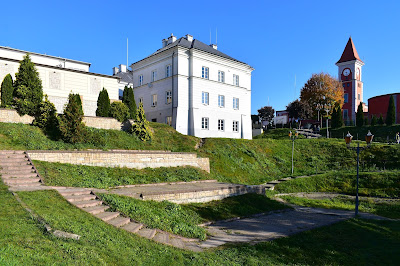The main difference between what in Poland is considered a village (wieś or wioska) and a town (miasto) is the presence of a market square. The former tend to be settlements strung out along a straight road with fields coming off it a right angles. The latter are typically built around a centre, dominated by a market square.
Warka, then, is a town of 12,000 people dating back to the 12th century, a centre for brewing and trade. For a while, Warka was bigger than Warsaw! The town suffered the usual devastation caused by various invasions, from the Swedes to the Germans; little remains of the town's pre-war appearance. In a straight line, about 50km south from the centre of Warsaw, 40km from Jeziorki and 15km from Jakubowizna. My Jeziorki neighbours, Tomek and Ania, suggested a visit to Warka's market on a Saturday morning, and so we went on a beautifully sunny early-autumn day.
Now, in England, the notion of a 'farmers' market' is a recent phenomenon, in Poland it never went away. It's worth pointing out here that the proportion of Polish society classed as urban today (62%) is the same as British society a century and half ago (61.8% according to the 1871 census).
A brief linguistic digression; Polish has three words for market - rynek, targ and jarmark. [There's also the loanword, bazar, as there is in English and many other languages.] 'Rynek' is the physical location for a market, while 'targ' is the event itself, taking place once or twice a week. But then 'targowisko' is also the physical location for a market! Historically, one of the principal rights of a town was to decide for itself on which days the targ would take place. Jarmark (from the German jahrmarkt) was an annually-held fair of regional rather than just local importance.
The bi-weekly market on Warka's targowisko (32,000m2) on Wednesdays and Saturdays (6am-noon) has vastly outgrown the town's rynek, a mere 1,500m2, and is situated in a large flat expanse of land below the escarpment, on the banks of the Pilica river.
Below: on the targowisko, behind it the escarpment of the Pilica, upon which stands the clock tower and water tank of the volunteer fire service. Beyond that, the old town square. Plenty of stands, tents, backs of vans, benches, people selling clothing, footwear, tools, fresh local farm produce, lumps of coal, furniture even. And lots of it.
This time last year:
How's your samopoczucie?
[three years on, pedestrians still risk their lives]
On relevance and irrelevance
This time seven years ago:
Poland gets anglicised as Britain gets polonised
This time eight years ago:
Ale, architecture and city politics
This time nine years ago:
The pros and cons of roadside acoustic screens
This time ten years ago:
Moaning about trains again
This time 11 years ago:
Warsaw street names - Dolna, Polna, Rolna, Wolna, Smolna. Lost?
This time 12 years ago:
Ditches, landscapes, autumn
This time 14 years ago:
Golden autumn in Łazienki park











No comments:
Post a Comment